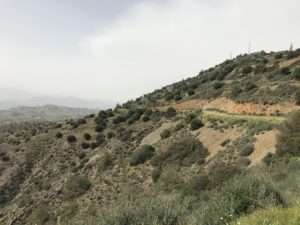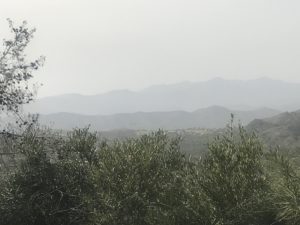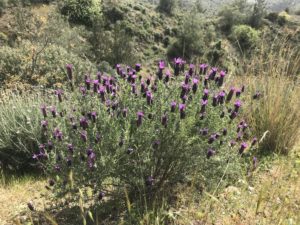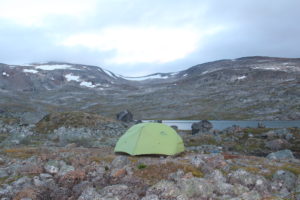



 The hiking was pretty soft and easy the whole afternoon and I’d guess I did around 18-19km (about 11 miles) total. I feel really good, still not hungry and energy is rather normal.
The hiking was pretty soft and easy the whole afternoon and I’d guess I did around 18-19km (about 11 miles) total. I feel really good, still not hungry and energy is rather normal.



 The hiking was pretty soft and easy the whole afternoon and I’d guess I did around 18-19km (about 11 miles) total. I feel really good, still not hungry and energy is rather normal.
The hiking was pretty soft and easy the whole afternoon and I’d guess I did around 18-19km (about 11 miles) total. I feel really good, still not hungry and energy is rather normal.So, finally I´d like to give You a list of what You need to pack for a longer hike of a few of more days and over night camping.
When it comes to Your personal gear I recommend to always get the best and lightest stuff that fits Your budget, especially if You want to stay away from mountain stations, cabins and other facilities as much as possible.
Naturally You´d need to pass by a cabin every now and then to wash Yourself and Your clothes, and maybe buy some provisions if You don´t want to carry everything from day one, yet the more remotely You want to roam, the more You need to be able to trust Your gear.
This is what You need to pack:
Now, this is the bare minimum for hiking considerably safe and comfortable, personally I would not leave anything from that list behind.
Some people want to bring additional stuff to make the trip more comfortable, always remember that You need to carry everything in and out of the wild and make sure that You´re ok with the weight before adding to Your pack, ok?
Thank You so much for checking out my blog, please share this with friends and loved ones who might benefit or be interested!
By leaving Your name and email in the box below You get notification of futures posts and news!
Peace // Claes
Hey, let´s just face it – most hikes are done in climate or surroundings that require some kind of clothing and the circumstances of Your hike will determine exactly what You need to wear.
Though many day hikes can be performed in just about any leisure pants and shirts, I definitely recommend to invest in some dedicated hiking clothes for any longer hike and also use them for day hikes as everyday garment has a tendency to wear and tear enormously fast when put to the test of nature!
This article is more of a checklist for You to pack the stuff needed for a medium to longer hike. Please observe that You might to add special equipment for a winter hike, or if You plan to cross glaciers etc, and that some stuff can be left out on a hike in guaranteed warm and dry climate.
So here´s the list:
Though I cannot recommend specific brands, due to variation in availability and the shear amount of producers, I would definitely ask You to get the most high end stuff that fits Your budget.
Outdoor clothing is normally very sturdy and, with the right care, serves You for years ot come unless You´re out in really rough conditions.
It´s definitely worth paying a little extra for the real quality stuff!
That said, I apply two principles myself to keep the costs down a bit (good equipment can be ridiculously pricy):
Planning You purchases can save quite a bit of money long term, and allow You to get quality that lasts and saves You even more. So don´t just go out there and buy everything at once, ok?
Thank You so much for checking out my blog, please share this with friends and loved ones who might benefit or be interested!
By leaving Your name and email in the box below You get notification of futures posts and news!
Peace // Claes

 Which to choose is basically up to Your preferences, though there are a few advantages to both models that might influence which one suits Your needs best.
Which to choose is basically up to Your preferences, though there are a few advantages to both models that might influence which one suits Your needs best.Thank You so much for checking out my blog, please share this with friends and loved ones who might benefit or be interested!
By leaving Your name and email in the box below You get notification of futures posts and news!
Peace // Claes
Oh yeah, this seems like an easy one, right? Just something to lie on, nothing special at all…
Well, there still are some decisions to make…
Mattresses basically come in two varieties, static and inflatable.
Remember the greyish roll of styropor mattress from the 80:s? They haven’t developed that much since, upside is they definitely kept there sturdiness. You just can’t break them by normal use, only remember to keep them out of the fire…
Downside: not very (or, to be frank, the least) comfortable
So, God bless Thermarest, giving us one of the first mainstream “self inflating”
mattresses some 20 years ago. Of course there’s nothing like a truly self inflating mattress, the foam filling somehow remembered its former volume and sucked some air into the device making the final filling with air so much easier.
Thankfully we’ve had quite some development here and today you can chose from a variety of different producers and models.
That mentioned you could probably find a pretty decent used car for the price of a high end mattress, filled with down, almost 4 inches thick and inflated by a built in pump, providing a level of comfort that is unchallenged by your bed at home. At the same time weighting down your backpack with 2kg (a good 4 lbs) or more. While at the other hand getting away from that bed at home might kinda be one reason for this whole hiking adventure.
In the case you intend to go hiking in polar conditions, or are extremely sensitive to cold climates, I’d definitely recommend a down filled mattress 7cm (roughly 2/5 inch) or thicker. For a summer hike while camping on soft ground a traditional static camping mat might be sufficient, leaving you huge budget space for other extravagances.
It all boils down to the same old questions to ask ourselves:
Where, when and how is the equipment to be used?
And then we chose the most appropriate option!
Please leave a comment below to let me know if this was helpful or if you have questions!
By leaving Your name and email in the box below You get notification of futures posts and news!
Good luck, have fun and love the experience!!!
Peace // Claes

By leaving Your name and email in the box below You get notification of futures posts and news!
Peace // Claes

Please leave a comment to tell me what You think and share this with friends and loved ones who might benefit or be interested!
By leaving Your name and email in the box below You get notification of futures posts and news!
Peace // Claes

Probably the most important choice for a successful and pleasant hike is which shoes to wear. As much as taste and personal preference plays in there are a few things to consider.
 At least when it comes to backpacks. Chose a small one and you’ll have all sorts of equipment strapped to the pack and get caught up in branches etc, chose a big one and you be prone to pack a bunch of stuff you don’t really need and have to carry that stuff around. The obvious solution is to have several different bags for hiking trips of different lengths though a minute personal discipline when packing does the trick just as well.
At least when it comes to backpacks. Chose a small one and you’ll have all sorts of equipment strapped to the pack and get caught up in branches etc, chose a big one and you be prone to pack a bunch of stuff you don’t really need and have to carry that stuff around. The obvious solution is to have several different bags for hiking trips of different lengths though a minute personal discipline when packing does the trick just as well.
The most important thing is to get one that fits your back comfortably enough to be carried for hours every day for a number of consecutive days and there’s no way to know that just from looking or trying it on in the store.
Yet loading it with 15, 18 or even 20kg (33, 40 or 44lbs) and carry it around inside for a weekend while going about your days would give you a pretty good feel for the equipment and how it fits your frame.
Thank You so much for checking out my blog, please share this with friends and loved ones who might benefit or be interested!
By leaving Your name and email in the box below You get notification of futures posts and news!
Peace // Claes